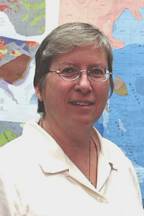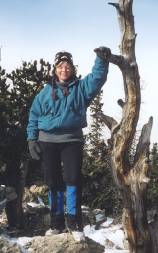aprilheader.html

Society
Page
News
about people and
announcements
from
AGI's
37 member societies
______________________ |
To
post news in Society Page, send e-mail to geotimes@agiweb.org
with the subject: Society Page. |
Contents:
GSA, new president
looking forward
 Geotimes
recently caught up with Sharon Mosher of the University of Texas, president
of the Geological Society of America (GSA). Mosher took the helm at GSA
beginning this year.
Geotimes
recently caught up with Sharon Mosher of the University of Texas, president
of the Geological Society of America (GSA). Mosher took the helm at GSA
beginning this year.
[At left: Sharon Mosher,
president of the Geological Society of America. Photo courtesy of GSA.]
What will it take to lead GSA under the Bush administration?
Now more than ever, all geoscience societies need to work together
to build a stronger awareness among the public and public policy makers
of the importance of basic and applied earth science research to society.
We need to speak with a united voice to have any influence on the course
this country takes in the areas of natural hazards, the environment or
research funding. I will be actively working toward better cooperation
and collaboration among geoscience societies and will be encouraging members
to become more active in the public domain.
What do you see as your greatest challenge in leading GSA?
The greatest challenge facing GSA today, and also its greatest opportunity,
is the transition to electronic publications and formation of electronic
journal aggregates. The challenge is to balance the financial risks with
the tremendous benefits from using new technology. I would like us to do
more than move our print journals online. I think we should be bold and
take advantage of the opportunities provided by the new technology, such
as publishing digital maps that display the geology, structure and topography
in three dimensions and allow the reader to view it from different perspectives.
We also need to ensure the continued use of our past literature and to
increase the interactive access to all geoscience journals. However, we
have to be fiscally prudent and keep this from negatively impacting other
critical GSA programs. To my mind, the greatest challenge in leading GSA
is maintaining a good balance between GSA’s activities in terms of publications,
meetings, member professional development, outreach and education.
What excites you about being president of GSA?
This is a time of growth for GSA. GSA is starting many new initiatives,
such as global meetings in cooperation with geoscience societies of other
countries and a public policy lecture series and listserve. GSA is exploring
new options in terms of publishing and member professional development.
To be involved in the beginning stages of planning and implementing these
new initiatives is very exciting. I am also looking forward to working
with GSA’s associated societies, other AGI member societies, and societies
in complementary disciplines to build better relationships and closer collaboration
scientifically and between outreach and education programs.
What questions do you hope earth science researchers will help answer
in the next decade?
I hope that through programs such as Earthscope, we can answer the
numerous questions related to active tectonics, such as: What physical
and chemical processes are acting within major plate-bounding faults? What
stress conditions cause earthquakes to initiate and propagate? What triggers
volcanic eruptions? How can we better predict tectonically generated natural
hazards? Other questions I hope researchers will find answers to include:
How are humans influencing climate change and how will these changes be
manifested in the future? What were the triggers and controls on climate
change in the past? What are the relationships between biologic and geologic
processes? Is there life in outer space?
Taking the
reins
On Feb. 19, the Society for Sedimentary Geology (SEPM) hired Howard
Harper as its new executive director. Harper graduated from Harvard University
with a doctorate in geology, focusing his research in biostratigraphy.
He then transferred his research experience to a job at ARCO, where he
later became director of stratigraphy research after dabbling in exploration
and business.
As executive director of SEPM, Harper will pursue the society’s
traditional goals: dedication to the dissemination of scientific information
on sedimentary geology, including sedimentology, stratigraphy, paleontology,
environmental sciences, marine geology and hydrogeology. “The challenges
that we face are maintaining quality publications and meetings in today’s
fast changing scientific and economic environment,” Harper says.
He is looking forward to increasing membership communication through
the Internet. International members can take advantage of the Spanish translation
of the SEPM Web site. SEPM is also increasing international membership
by establishing new sections and joining in international meetings. “We
have also funded several international students to attend our annual meeting,”
Harper says. “We will continue working on our international presence
and student involvement.”
“We will continue working on our international presence and student
involvement.”
Harper attended the Geological Society of America’s (GSA) Forum for
Associated Societies in Boulder on Feb. 23. Representatives from most of
the associated societies discussed initiatives for cooperation in the geologic
areas of education, public outreach, publications, meetings, global ventures
and professional development. “We have strong relationships with AAPG [American
Association of Petroleum Geologists] and GSA and are looking forward to
working with other geoscience societies in areas of mutual interest.”
Student grants
The Society for Organic Petrology (TSOP) invites applications for graduate
student research grants. The purpose of the grants is to foster research
in organic petrology by providing support to graduate students from around
the world who demonstrate the application of organic petrology concepts
to research problems.
The society will grant up to $1,000. TSOP will also provide Merit Awards,
in the form of certificates redeemable for TSOP publications, to top-ranking
applicants not receiving grants.
The program awards a maximum of two grants each year.
The application deadline is May 15. Grants will be awarded in September
2001. Watch for detailed information and an application form on the TSOP
Web site, www.tsop.org/grants.htm. Applications may also be obtained from
S.J. Russell, Shell International E&P, Inc., 3737 Bellaire Blvd., Houston,
TX 77025, USA. Phone: 713-245-7603. Fax: 713-245-7599; E-mail: srussell@shellus.com.
Moving mountains
 The
American Geological Institute’s Past President Susan Landon was named president
of the Rocky Mountain Association of Geologists (RMAG) early this year.
The Rocky Mountain organization is the second largest affiliated society
with the American Association of Petroleum Geologists, providing 18 members
to the AAPG House of Delegates.
The
American Geological Institute’s Past President Susan Landon was named president
of the Rocky Mountain Association of Geologists (RMAG) early this year.
The Rocky Mountain organization is the second largest affiliated society
with the American Association of Petroleum Geologists, providing 18 members
to the AAPG House of Delegates.
[At left: Susan Landon winter
climbing the Colorado Front Range. Photo courtesy of S. Landon.]
Landon is an independent petroleum geologist affiliated with Thomassan
Partners Associates, an oil and natural gas exploration group. RMAG is
a nonprofit organization that caters primarily, but not exclusively, to
geologists operating in the petroleum industry. The organization also focuses
on the practical applications of those sciences, fosters scientific research,
and encourages fellowship and cooperation among its members.
Landon is looking to push the society toward a more proactive stance
on public lands. Specifically, it will look at the Bureau of Land Management
and at forest lands in the Rockies that provide some of the major natural
gas provinces in the United States. “RMAG has been reluctant to get involved
in any political act and I would like to move RMAG cautiously to becoming
a little more proactively involved in developing public policies such as
appropriate access to public lands,” Landon says. Society members will
soon comment on a drafted public policy statement on access to federal
lands.
Another area in which Landon sees room for improvement is with RMAG’s
involvement in outreach to the general public and school children. She
is currently working to expand the committee that provides speakers to
schools. “We have more requests then we can fill,” she says. “I would like
to increase enthusiasm among the members to understand the importance of
and to be more active in outreach.”
Landon is an avid mountain climber and has hiked Mount Kilimanjaro,
Mount Rainier and Mount Whitney. “I’m goal oriented and to have a mountain
peak as a goal I think reflects part of my personality,” she says.
Associate Editor Christina Reed compiles
Society Page.
 The
American Geological Institute’s Past President Susan Landon was named president
of the Rocky Mountain Association of Geologists (RMAG) early this year.
The Rocky Mountain organization is the second largest affiliated society
with the American Association of Petroleum Geologists, providing 18 members
to the AAPG House of Delegates.
The
American Geological Institute’s Past President Susan Landon was named president
of the Rocky Mountain Association of Geologists (RMAG) early this year.
The Rocky Mountain organization is the second largest affiliated society
with the American Association of Petroleum Geologists, providing 18 members
to the AAPG House of Delegates.

 Geotimes
recently caught up with Sharon Mosher of the University of Texas, president
of the Geological Society of America (GSA). Mosher took the helm at GSA
beginning this year.
Geotimes
recently caught up with Sharon Mosher of the University of Texas, president
of the Geological Society of America (GSA). Mosher took the helm at GSA
beginning this year.
